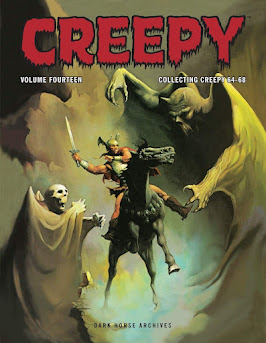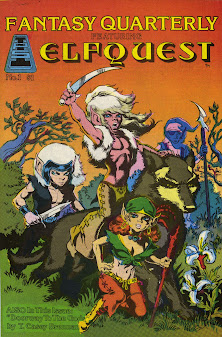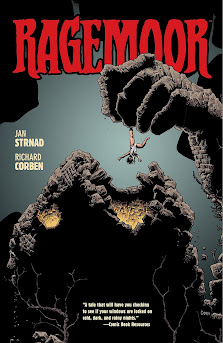A Conversation with Writer and Indie Comix Legend JAN STRNAD - Part Three
Cereal At Midnight sits down with writer and indie comix giant Jan Strnad to talk about the early days of comics, sci-fi, fantasy, and horror fandom, his years at Disney TV Animation, writing Star Wars, and his decades-long working collaboration with illustrator Richard Corben.
(Continued from Part 2)
Cereal At Midnight: Given everything that we've talked about and your insight into the world of big franchises, corporate mandates, and executives who aren't familiar with the source material that serves as the foundation for their tentpoles, the value of independent creation seems more important than ever. Can you talk to me about the importance of underground comics and creators, both when you were first starting out and as you see the medium today?
Jan Strnad: I grew up with comics published under the Comics Code Authority and only discovered the pre-code comics in my late teens. The EC line in particular blew my mind because the comics were so literate, sometimes adapting Ray Bradbury, sometimes with original stories of merit, and the artwork was often phenomenal. Besides the ECs, though, there was a lot of lurid crap. But that’s okay, because everything can’t be cream. Cream has to have something to float on top of. Plus, I kind of like lurid crap sometimes.
The Warren books, Creepy and Eerie were great because, again, there was top-notch art, but they also skirted the CCA. They avoided the censor by using a magazine format but didn’t go overboard. For horror comics, they were still pretty tasteful, certainly moreso than the pre-code horror comics.
The undergrounds were created by a demographic that was in full rebellion mode, so when these creators made comics, they went out of their way to do everything the CCA said they couldn’t do: graphic nudity, sex, drugs, illegal behavior, smoking, violence, irreverence, blasphemy, the whole works. They went beyond the super-hero comics with street-level stories, fantasy, science fiction, ecological stories, and even when they did a super-hero it was way over the top like Gilbert Shelton’s Wonder Wart-Hog, And again, a lot of it was crap. But some of it wasn’t, and some of it was downright brilliant such as Robert Crumb, Vaughn Bode, Shelton, Jay Lynch, Rich Corben, and others.
Finally, there was Heavy Metal magazine, the American version of the French Metal Hurlant. Metal Hurlant was created by comics artists Jean "Moebius" Giraud and Philippe Druillet together with writer Jean-Pierre Dionnet. As you’d expect, Metal Hurlant and the American Heavy Metal took a distinctly French approach to storytelling, as different from American comics as French movies are different from American films.
I took a story structure class from screenwriting guru Robert McGee. He had a great little way of describing the difference between French and American movies. It went like this: In a French movie, the first shot is a sky full of beautiful, fleecy clouds. The second shot is a sky full of beautiful, fleecy clouds. And the third shot is… a sky full of beautiful, fleecy clouds. In an American movie, the first shot is a sky full of beautiful, fleecy clouds. In the second shot, an airplane bursts through the clouds. In the third shot, the plane blows up. I think he sums up the difference very vividly!
I’m deeply steeped in American storytelling, so Heavy Metal was a mixed blessing for me. Stunning visuals, and stories that often didn’t seem to go anywhere.
Now, when you look at the entire comics field with all of these outlets back when I was getting started writing comics, you see that it was pretty heady mix. I had my childhood influences, my adolescent influences (mainly, Marvel comics), but I was also developing a sense of comic book history with the pre-code stuff, I was up to my neck in rebellious hippie, counter-culture comix, my first sales were to Warren, and I ended up working with Rich Corben on material for Heavy Metal. I also wrote comics for the independent American publisher Fantagraphics, which inhabited a strange space between American super-hero comics and European comics.
All of these influences are important. The mainstream of any medium has the most profound influence on the mass culture, but the independents, the undergrounds, etc. are important in keeping the medium vital. Some of this material gets absorbed into the mainstream, like Star Wars, which had its origin as a relatively low-budget feature that the studio, 20th Century-Fox, tossed out to thirty theaters convinced it had a turkey on its hands. Now Star Wars is deeply ensconced in mainstream American culture. Other material tries to go mainstream and falls flat. I think of the recent Fabulous Furry Freak Brothers animated series that failed sadly to capture the spirit of Gilbert Shelton’s underground comic. I think it’s entirely possible that the Fabulous Furry Freak Brothers is in its most perfect form already, as a comic book.
I heard about a meeting at either Warner Bros. or Universal where the studio was about to license the Hernandez brothers’ Love and Rockets. As I was told the story, they were at the studio, in an office, about to sign the contract, and Jaime’s hand just froze. He couldn’t do it. He just couldn’t bring himself to do it! He knew that chances were that whatever magic gives Love and Rockets its charm would be lost in translation to other media.
I think that Wendy and Richard Pini are in much the same boat. It isn’t that there’s any lack of interest in their self-published Elfquest, which has been a shining success in the independent comics field for almost forty years. The problem is, they want… demand… to see any film or television project done right. And the big media companies can’t be trusted to get it right. It isn’t a children’s property, for one thing. It’s sexy and sometimes violent and Elfquest wouldn’t be Elfquest without those elements. But media companies have a hard time seeing past what they consider a “cute” illustration style.
Jeff Williams faced the same problem with his film MEAD, based on an underground story of mine that Rich Corben illustrated. Because the undergrounds practically demanded nudity, the opening frame of the story, “To Meet the Faces You Meet,” is a nude woman riding a naked man. Jeff wanted to remain as faithful to the original story as possible and for years he couldn’t figure out how to get past that opening shot. Eventually he simply toned it down and put clothes on the actors and backed away from the coitus to pre-coitus. Still, when he was shopping for a distributor, that opening scene was almost too much. Because one of the main characters is a “cute”-looking flying robotic head, the distributor kept looking at MEAD as a children’s movie. Language was toned down wherever possible, and the pitch had a “younger audiences” feel to it. Maybe they have their fingers on the public pulse better than Jeff does. I don’t know. We’ll see how it goes.
These are the hazards of going from one medium to another, especially from independently created work to mass media. The larger media company executives might not get the material, and it’s always possible that the material just naturally won’t transition well. As with the Fabulous Furry Freak Brothers and possibly Love and Rockets, it could be in its most perfect form already as a comic.
Thanks to digital effects, the Marvel super-heroes have made the transition fabulously. Before those effects and mega-budgets, those early efforts such as Captain America and Doctor Strange fell short. If you Google “Captain America films in order” you won’t even find the 1990 film listed. You have to dig. And the 1978 Dr. Strange made-for-TV movie that gave Strange a porn star moustache was even more embarrassing. Once the budgets and digital effects kicked in, Marvel was off and running.
Still, the studios are more than capable of blowing it. I think of the Swamp Thing television series based on the DC comics. It was a really good show, very popular, with great ratings, but Warner Bros. killed it in the middle of the tenth episode out of a planned thirteen-episode season. Why? One executive didn’t like it. Didn’t matter that it was a hit. He didn’t like it and he killed it because he could.
Cereal At Midnight: You mentioned Richard Corben, with whom you had a forty-plus year friendship and working relationship. There is arguably no other person who can speak about Corb and his work with as much first-hand knowledge and experience as you and I'd love to hear what it was like to collaborate with him.
Jan Strnad: Richard Corben was a unique individual. You’re right that I worked with him on and off for more than forty years. He was a great artist with a terrific sense of visual storytelling. He took great pride in his work. He posed models. He made small busts of characters so that he could light them and get the shadows right when he drew them. He was always experimenting with multi-media. His color palate was unique. He never stopped pushing himself until the day he died.
I rode Corb’s coattails shamelessly. I never turned him down for a project, though he turned me down a couple of times. Once was for a Weird War Tales story I’d pitched. It was a Nazis vs. dinosaurs story, but it all took place inside a wounded, delirious soldier’s head. It was a very touching, Bradbury-esque story called “Private Parker Sees Thunder Lizards.” I pitched it to Corb and he turned it down, saying that he thought that Nazis vs. dinosaurs was a silly idea. DC Editor Joey Cavalieri bought it anyway and Gabriel Hardman did a great job illustrating it. When Corb saw it, he sent me an email saying that he was sorry to have turned it down, that it made sense the way I’d written it, having all the dinosaur action take place in the soldier’s imagination.
Now, this was the thing about Corb. I don’t think he really understood a story until he saw it visually, which meant that most of the time he was working on faith with me. The story didn’t grok with him until he drew it. I’d made it very clear in the synopsis that the soldier was hallucinating the dinosaurs, but Corb didn’t pick up on that until he saw the finished comic.
Similarly, when the Ragemoor graphic novel was finished, he said that it held together much better than he thought it did while he was drawing it, even though the whole story had been plotted out in advance and I’d written a detailed synopsis.
I didn’t come to this realization about how visually oriented Corb was until late in our collaborations. It boggles my mind that he did so much work taking my word for it that the story would hold together and make sense.
Speaking of Ragemoor, Corb chided me at the end for being too hard on the characters. He’d grown quite fond of them and thought I was treating them too harshly. I agreed to soften the ending and pitched a different ending to him, one that he found acceptable. The ending to the published book is pretty grim still. I can’t remember the original ending but I’m glad he got me to tone it down a bit, because it’s enough of a downer as it is!
Over the years, while he was going deeper into explicit, adult material, I went the other direction, into television animation. Most of my work was for Disney. But now and again a project would come along, like the Spirit story we did or the story I sent him for his Shadows on the Grave series, and we’d fall right into it as if no time at all had passed.
Corb was a great artist and a great human being. I miss him every day.
Cereal At Midnight: Finally, can you refer readers to where they can discover your underground comics work? Most of the Marvel, DC, and Dark Horse publications remain in print, both physically and digitally. Underground and independent comics, however, can be a little bit more difficult to find these days. Are there any reprints or digital versions that you can point to for new readers?
Jan Strnad: All of the graphic novels with Corb are being reprinted and will be available. Mutant World and Son of Mutant World were reprinted in a very nice volume by (ahem) myself as a Kickstarter project. Copies are still available from Stuart Ng Books online. The others will be coming along under Dona Corben’s guidance. The underground work is tougher. I don’t know if it will be collected or not, but I hope it is. The underground work I did with other artists is probably lost unless you can find a copy of the original comic floating around.
Cereal At Midnight: This has been an absolute pleasure, as well as a fascinating and informative experience. Thank you so much for taking the time to talk to me!
Jan Strnad: Thanks very much for the chance to opine and reminisce!
Jan Strnad is an award-winning writer, known for five decades of sci-fi, horror, and comics tales. He has also written for almost two dozen animated television series and is co-creator of the underground comic Fever Dreams, which has been adapted into the feature film MEAD.
Read the whole conversation!















Excellent interview! Unfortunately, "Mutant World" is no longer available from Stuart Ng.
ReplyDelete